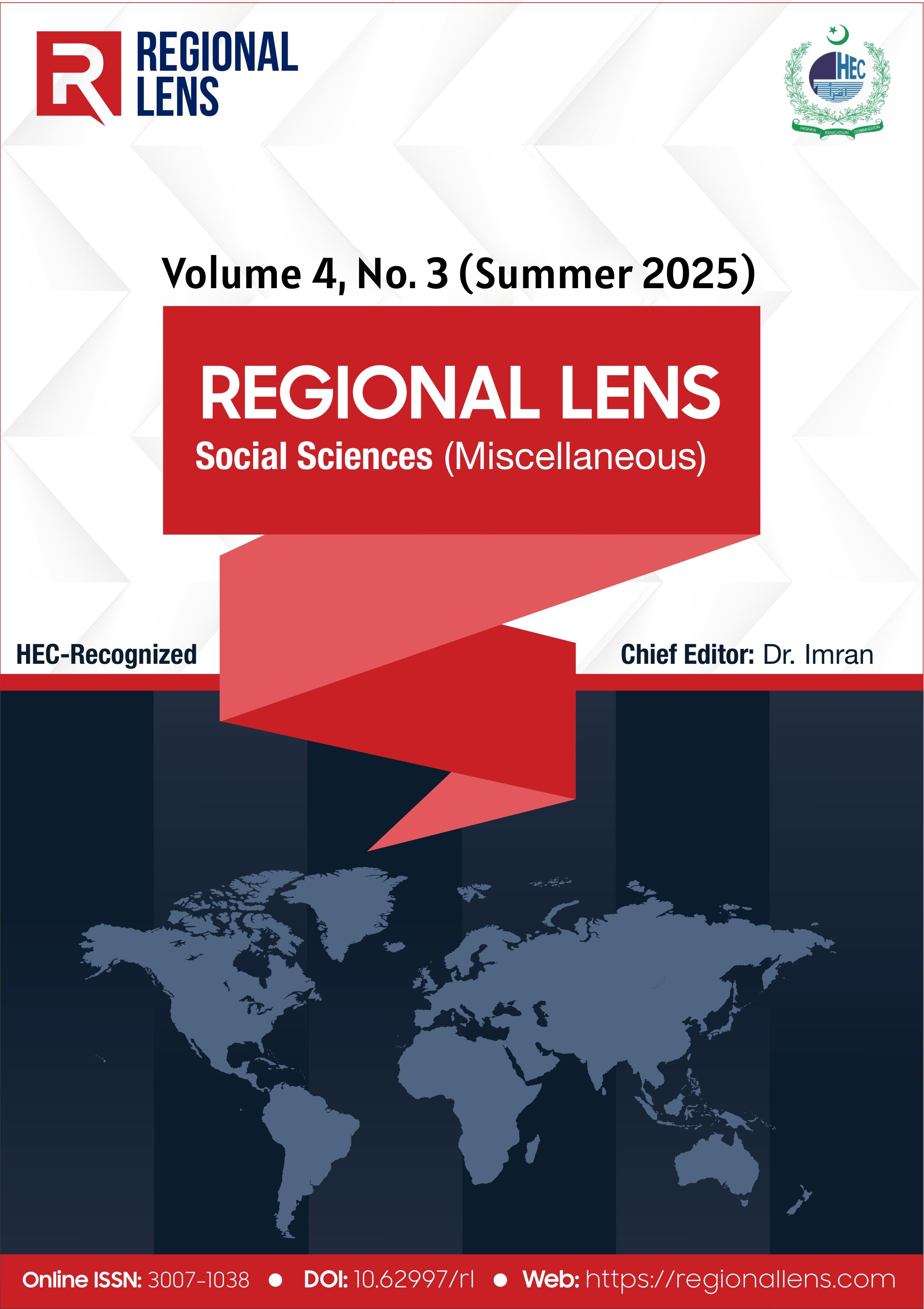Evaluating the Impact of Shelter Home Services on the Well-Being and Satisfaction of Residents in Pakistan
DOI:
https://doi.org/10.55737/rl.2025.43103Keywords:
Panah Gah, Homelessness, Shelter Home, Poverty Elevation, Structural Equation ModelAbstract
Shelter homes are vital in combating homelessness by providing temporary accommodation and essential services, including food, healthcare, and, in certain instances, education and transportation. The government of Pakistan has initiated the "Panah Gah" programme to assist the homeless population in multiple cities. This study evaluates the effectiveness of the Panah Gah initiative in Lahore, with a specific focus on service provision and resident satisfaction. Data were collected from 150 homeless individuals living in five major Panah Gahs situated at Data Darbar, Railway Station, Thokar Niaz Baig, Badami Bagh, and Lorri Adda. A structured and pre-tested questionnaire facilitated primary data collection, which was subsequently analysed using Structural Equation Modelling (SEM) through SPSS. The results indicate that shelter quality and service quality are significantly and positively correlated with resident satisfaction, with coefficients of 0.92 and 0.46, respectively. In the context of shelter quality, the staying experience emerged as a significant factor (0.42), while resident control did not demonstrate significance (0.04). For service quality, reliability (0.99) and responsibility (0.79) were key contributors. The study recommends more flexible entry timings, dedicated spaces for homeless women with female staff, and expansion of the program to other districts to enhance its overall effectiveness and reach.
References
Benjaminsen, L. (2018). Housing first in Denmark: an analysis of the coverage rate among homeless people and types of shelter users. Social Inclusion, 6(3), 327-336. https://doi.org/10.17645/si.v6i3.1539
Borsboom, D., Mellenbergh, G. J., & van Heerden, J. (2004). The concept of validity. Psychological Review, 111(4), 1061–1071. https://doi.org/10.1037/0033-295X.111.4.1061
Chin, W. W. (1998). The partial least squares approach to structural equation modeling. In Modern methods for business research (pp. 295-336). Psychology Press.
Evans, W. N., Sullivan, J. X., & Wallskog, M. (2016). The impact of homelessness prevention programs on homelessness. Science, 353(6300), 694-699. https://doi.org/10.1126/science.aag0833
Fiorati, R. C., Arcêncio, R. A., & de Souza, L. B. (2016). Social inequalities and access to health: challenges for society and the nursing field. Revista Latino-Americana de Enfermagem, 24, e2687. https://doi.org/10.1590/1518-8345.0945.2687
Gaetz, S., Gulliver, T., & Richter, T. (2014). The state of homelessness in Canada 2014. Canadian Homelessness Research Network.
Ghosh, S. (2020). Understanding homelessness in neoliberal city: A study from Delhi. Journal of Asian and African Studies, 55(2), 285–297. https://doi.org/10.1177/0021909619875775
Goel, G., Ghosh, P., Ojha, M. K., & Shukla, A. (2017). Urban homeless shelters in India: Miseries untold and promises unmet. Cities, 71, 88–96. https://doi.org/10.1016/j.cities.2017.07.006
Goel, K., & Chowdhary, R. (2017). Living homeless in urban India: State and societal responses. In C. Zufferey & N. Yu (Eds.), Faces of Homelessness in the Asia Pacific (pp. 47–63). Routledge. https://doi.org/10.4324/9781315475257
Hameed, R., Aslam, A. B., & Khan, M. S. U. (2025). How Pannah Gahs (shelter homes) are helping the homeless people in Lahore, Pakistan. Journal of Housing and the Built Environment, 40(1), 417–439. https://doi.org/10.1007/s10901-025-10175-4
McVicar, D., Moschion, J., & van Ours, J. C. (2015). From substance use to homelessness or vice versa. Social Science & Medicine (1982), 136–137, 89–98. https://doi.org/10.1016/j.socscimed.2015.05.005
Montgomery, A. E., Fargo, J. D., Byrne, T. H., Kane, V., & Culhane, D. P. (2013). Universal screening for homelessness and risk for homelessness in the Veterans Health Administration. American Journal of Public Health, 103(S2), S210-S211. https://doi.org/10.2105/ajph.2013.301398
Nunnally, J. C. 1978. Psychometric Theory: 2d Ed. McGraw-Hill.
Patten, S. B. (2017). Homelessness and Mental Health. The Canadian Journal of Psychiatry, 62(7), 456-459. https://doi.org/10.1177/0706743717711423
Premsingh, J. G., & Ebenezer, W. D. (2013). Homelessness and residential care. Journal of Humanities and Social Science, 9(1), 46-52. https://www.iosrjournals.org/iosr-jhss/papers/Vol9-issue1/H0914652.pdf
Rahman, M., & Hasan, M. M. U. (2023). Pavement Dweller Center (PDC)-An innovative one-stop service for homeless people: The case of Sajida Foundation’s Amrao Manush project. Community Development, 54(1), 72–90. https://doi.org/10.1080/15575330.2022.2028300
Shah, R., & Goldstein, S. M. (2006). Use of structural equation modeling in operations management research: Looking back and forward. Journal of Operations Management, 24(2), 148–169. https://doi.org/10.1016/j.jom.2005.05.001
Speak, S., & Tipple, G. (2006). Perceptions, persecution and pity: The limitations of interventions for homelessness in developing countries. International Journal of Urban and Regional Research, 30(1), 172–188. https://doi.org/10.1111/j.1468-2427.2006.00641.x
Subramanian, N., Gunasekaran, A., Yu, J., Cheng, J., & Ning, K. (2014). Customer satisfaction and competitiveness in the Chinese E-retailing: Structural equation modeling (SEM) approach to identify the role of quality factors. Expert Systems with Applications, 41(1), 69–80. https://doi.org/10.1016/j.eswa.2013.07.012
Sylvestre, J., Klodawsky, F., Gogosis, E., Ecker, J., Polillo, A., Czechowski, K., Agha, A., Shankar, S., To, M., Gadermann, A., Palepu, A., & Hwang, S. (2018). Perceptions of housing and shelter among people with histories of unstable housing in three cities in Canada: A qualitative study. American Journal of Community Psychology, 61(3–4), 445–458. https://doi.org/10.1002/ajcp.12243
Terry, P. (2019). Shelter briefing: Long-term commitment to increased provision of social housing to help to reduce housing costs, homelessness and housing benefit expenditure.




